
This article appears in the new issue of DEN OF GEEK magazine. You can read all of our magazine stories here.
Before he ever settled on a pitch to 20th Century Studios, Fede Alvarez invited close friends and colleagues, cinephiles, and horror connoisseurs, into his home. At this point in his career, the Uruguayan director had once already pulled off a magic trick by becoming the first person not named Sam Raimi to helm an Evil Dead movie. Miraculously, he was celebrated for that walk across cinematic holy ground. Now, Alvarez wanted to workshop an even more death-defying stunt. He was going to share fledgling ideas for a new Alien film.
Over conversation and drinks, Alvarez teased the broad strokes of what he had in mind, from keeping one element of the franchise’s lore to perhaps jettisoning another; he would repeat this iconic detail of H.R. Giger’s creature design, but he’d also change that aspect to make it his own. He would find a way to reinvent the franchise. By the time it was over, friends stared in disbelief.
“Why are you trying to fix something that is perfect?” he was finally asked. “Do not fuck with those things,” said another. Looking back at the chat now, Alvarez can’t help but laugh and perhaps be a little grateful. “Everybody has to thank them because it made me realize that certain things are true,” Alvarez says. “You want the pure, unaltered classic version of it, and then you can innovate by the new things you add.” You want what an Ian Holm character famously dubbed “the perfect organism.”
These appear to have become words to live and, in the case of some characters, die screaming by in Alien: Romulus, the seventh film in the venerated science fiction series. More than any other Alien continuation in the last 30 years, Romulus is laser-focused on recapturing the cosmic dread of the 1979 masterpiece from director Ridley Scott and the high-octane adrenaline of James Cameron’s radically different follow-up, Aliens (1986). It’s a deliberate return to why audiences recoiled in the first place at the sight of a dripping, drooling beastie who’s desperate to put something inside you.
“Just picking apart what makes those films in particular work so well in such different ways was really fun as a lover of film in general, but especially this franchise,” says Romulus’ leading lady, Cailee Spaeny. The impulse to serve both styles can lead to mornings where Spaeny is asked by the director what is the “indie movie version” of the scene they’re filming, and afternoons where she’s covered in blood and holding a quasi-flamethrower for a hero shot taken out of Cameron’s playbook.
“There’s a moment where I’m coming out of the elevator with the pulse rifle, and I’ve got two guys behind the camera with leaf blowers hitting me, and we’re really leaning into the ’80s drama of it,” she enthuses. “It’s amazing.” It’s also a homecoming for a franchise that’s traveled light years from its roots.
Origin of the Species
When we catch up with Alvarez, he’s at the finish line on Romulus. On this particular evening, he has just wrapped a round of press in Paris, and tomorrow, he’ll be back to Los Angeles, where he has one more day of sound mixing before the picture is locked. He likens it to an expectant mother in her ninth month of pregnancy. Or John Hurt moments before dinner on the Nostromo.
But then, the Alien movies have always loomed large in Alvarez’s mind. He was a shade too young to experience Scott’s haunted-house original during its first theatrical release (Alvarez was born in 1978), but he was there for the Aliens tidal wave in ’86, which in turn led to him watching Alien countless times at home. Alvarez even speaks fondly of more contentious entries in the series, be it Alien: Resurrection or how he got into debates on the Evil Dead set after the whole crew saw Prometheus over the weekend. “That’s a movie that clearly accomplished more than most movies ever do,” he insists.
Yet it’s always been about the original two entries when it comes to the Alien franchise, and now by extension, Alien: Romulus. Upon getting the gig, Alvarez sought out those who were there opening night in ’79 to better understand why the movie left such a scar on the cultural psyche. And Alvarez has attempted to instill some of those lessons into Romulus, even as he also hopes to make “a full meal” that’s fresh for xenomorph veterans and newbies alike.
Take the ensemble assembled in Romulus, for example. Whereas Alien famously followed “space truckers” (blue-collar stiffs marked as expendable by their company), and Aliens pivoted toward “colonial marines,” Alien: Romulus, which is set in the 57-year gap between those two films, takes a page from a half-forgotten deleted scene in Aliens and blows it up into its own saga of dreams and screams. It follows space colonists who are too young and desperate to know the kind of nightmare that they’re getting themselves into.
“They’re inspired by [that deleted scene] when you see a bunch of kids riding around Hadley’s Hope,” Alvarez explains. “I remember seeing that and thinking that’s tough for those kids. If they didn’t die a week later and they grew up to be adults, it would have been hard to live in a colony where there’s no future. You’re either a farmer or a miner, and that’s all you can be, and it’s going to take 50 years for the atmosphere to be ready. Human beings, we’re not cut out for that.”
No, Future, No Hope, and an Android Like No Other
Things are indeed grim for the children of a remote outpost at the beginning of Romulus. They’re a generation of young adults who have lived long enough to see the company abandon their colony, leaving them without resources or opportunity. This includes a girl named Rain (Spaeny) and her surviving friends and family, all of whom are anxious enough to scheme for a better life on a space station called Renaissance.
As with the plight of the crew of the Nostromo, Spaeny sees plenty of parallels between how folks live today and Romulus’ cast of refugees.
“They feel like they come from a truthful blue-collar world,” says the star. “I’m from southern Missouri. I come from a long line of farmers and blue-collar people, which was my main source of inspiration. I wanted her to feel very Americana, very sort of meat and potatoes.” This drips all the way into the movie’s central relationship: the love between Rain and her brother. But who that brother is reframes the chilliest subplot of the Alien franchise, since he’s also an android named Andy (David Jonsson).
“It is what Ridley [Scott] identified early on as the heart of the movie when I pitched him,” Alvarez recalls of his meeting with the Alien director and Romulus producer. “[He said it’s] what people are going to really connect to, and that’s true.” While humans and robots have had a spectrum of relationships across previous Alien movies, making a “synthetic” part of the family opens a whole new can of worms.
In the film, Andy is a “passing gift” Rain’s father bequeaths to her. At the time, Rain is still a child, and Andy becomes both a surrogate brother and caregiver. Given the history of androids in the Alien franchise, that should probably raise immediate red flags—as should any knowledge of the story of Romulus and Remus from which the film derives its title. Yet both Jonsson and Spaeny insist the characters’ sibling dynamic is genuine and loving.
“We have this incredible, complex relationship that basically sees us through this film,” Jonsson says. And while Andy is made by Weyland-Yutani, the actor points out that so was Lance Henriksen’s benevolent robot Bishop in Aliens.
“I think that there is something inherent in every single synthetic [in this series],” Jonsson continues. “You don’t know whether one’s going to do right or go the other way. I think that’s the wonder of what Alien is. But I can definitely assure you that Andy is very, very different from any synthetic you’ve seen before.”
For Alvarez, it gets to something more personal: what he calls the responsibility of siblinghood. As someone who grew up with several brothers, it was a culture shock when he first came to the U.S. and people would ask him if he was close to his brothers. Why wouldn’t he be? He suspects the size of one’s country influences this perception, just as it might affect what he sees as a glaring blindspot in Hollywood movies.
“There have been a lot of movies made about what it means to be a parent or what it means to be a lover. But siblinghood is one that hasn’t been explored enough for me, at least,” says the director. “It’s very easy to say the words ‘you’re my brother, you’re my sibling,’ but a different thing is to act and really be ready. Would you die for your brother? Would you die for your sibling, particularly when they’re not really related by blood?”
The director thus suggests Andy is closer to how replicants are depicted in the Blade Runner movies: “The android represents the oppressed minority, the different one, the one that lives among us, and he’s supposed to be a friend, but you’re truly kind of exploiting him. It’s like you find a legal, accepted way to have a slave sometimes.”
Fiercer Creatures
If the idea of what a “synthetic” can be is always evolving, the Star Beast of the Alien franchise’s title remains terrifyingly constant. “They really are hellish, those designs,” Spaeny muses of the Giger concepts that return in their full glory in Alien: Romulus. “I remember doing research on what the drawings of the creatures were before H.R. Giger came along, and they had eyeballs and funny little arms. They looked more like the aliens we would imagine in our heads if we drew them on a piece of paper. So there’s something striking in the restraint of those designs that ended up being the iconic xenomorph. The attachment of the human anatomy is just really strange, confrontational, and uncomfortable.”
Romulus’ iteration is closer to Giger and Scott’s original ideal than any previous Alien sequel, too. Alvarez insisted on restoring the Star Beast’s K-Y Jelly-doused dome after Cameron nixed the visual in 1986. But it wasn’t only the first xenomorph that the director exhumed from the 20th Century Studios vaults.
“One of the key factors behind those original movies, apart from Ridley and Cameron, is also Ron Cobb and Syd Mead, these mythical designers,” Alvarez says of the concept artists who worked on the first two films. “So we went back to their drawings, and there’s some stuff in our movie inspired by sketches that Ron Cobb did for the original Alien that were not used. We took those and we brought them to life.”
But “life” might be a poor choice of words when describing the Renaissance space station. With two sections, ominously known as “Romulus” and “Remus,” the station is in a state of cascading failure when the film’s young colonists arrive. Furthermore, the way the leads tell it, there was barely a green or blue screen in sight on the sets, which made the sweaty, claustrophobic horror real.
“A fear with these films is you’re going to sign on to something and you’re going to spend six months in front of a green screen reacting to a guy waving around a tennis ball, which I’ve done,” Spaeny says. “That’s why the first conversations with Fede were so exciting, and I really hope it works, because it made such a difference for us as actors that Fede decided his biggest battle was to fight for everything [being] practical.”
Alvarez explains it more simply: any Alien movie worth its acid blood should be suffused with atmosphere. That instantly negates too many digital enhancements.
Says the director: “If you put in a CG extension of the set, you can’t put any smoke in it. That’s why they look so sterile in some movies. Our movie has smoke everywhere because if you want to be an Alien movie, you need to have smoke pumping in every corner all the time. It also didn’t allow us to have CG creatures for the most part because once you fill the space with real smoke, it’s really hard to compose any CG element. So as a consequence of building the set like that, we also needed real creatures that would move through the space.”
The result of this approach was an intensely tactile experience where basic actions could become surprisingly challenging.
“This is probably a Fede request; it would sound like something he’d make sure happened,” Spaeny chuckles, “but [the pulse rifle] was really heavy. To the point where he’d do ongoing rolling takes over and over again until I would just scream, ‘I can’t keep it up any longer!’ Which I’m sure he’s like, ‘Well, that’s what I was going for.’”
All that effort, though, is in service to a primal story that the Romulus star likens to generational folklore. The new movie even has some of the same folks who worked on the xenomorphs way back in 1986 applying the acid today.
“That is the ground-level bones of this film, the creature,” Spaeny considers. “And I think more than feeling shock and horror, it’s really love that has been passed down and injected in the making of these creatures. The people that were on our film that also worked on Alien and Aliens, they have spent an entire working lifetime dedicating themselves to this iconic creature. This is sort of a continued tradition that’s been passed on. It comes back to something in us as little kids who come across these creatures.”
It is an icon of Freudian menace that has burrowed its way deep into our nightmares. Why mess with that?
Alien: Romulus is released in theaters on Aug. 16.
The post Alien: Romulus – Exclusive Look at the Return of Xenomorphs, Androids, and Cosmic Dread appeared first on Den of Geek.






